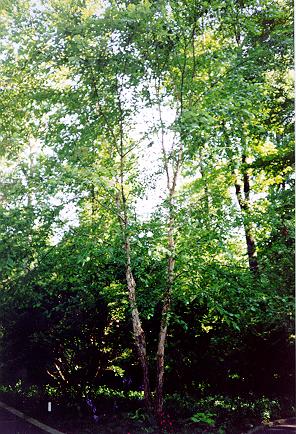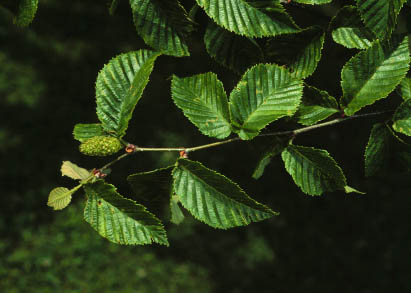
Betula nigraRiver birch
 Betula nigraRiver birch |
| Discover Life | All Living Things | Plantae | Betula |
The Birch family has six genera. Five of the six genera occur in North America. These five are Betula (Birches), Alnus (Alders), Carpinus (Hornbeams), Ostrya (Iron-wood), and Corylus (Hazel). This family ranges from medium sized group of trees to medium and small shrubs. The Birch Family is most common in the northern hemisphere, but can occassionally be found in the southern hemisphere. There are approximately 105 species in the Birch family. Most of this information was obtained from Elias, 1980 and Brown & Kirkman, 1990
The Genera that will be focused on is Betula. The Betula genus is comprised of both trees and shrubs. The species that makeup this genus grow throughout the northern hemisphere. Greater than fifty percent (8 out of 15) of the species that are native to North America are trees. These trees usually range from small to medium sized. The bark of some of the birch trees is known for its flaking and pealing nature. Bark colors can be dark red/brown, light gray, or black. Leaves range in shape from triangular to oval. The alternating leaves have a double toothed edge and have pointed tips. Most of this genus flowers. Both the male and the female flowers hang in cluster formations known as catkins. These trees reproduce through the production of small winged seeds that can be produced every 1 to 4 years. Most of this information was obtained from Elias, 1980.
Betula alleghaniesis Britt.------yellow birch
Betula X alpestris Fries--------birch
Betula borealis Spach----------northern birch
Betula X caerulea Blanch.-------birch
Betula X dugleana--------------Dugle's birch
Betula X dutillyi---------------Dutilly's birch
Betula X eastwoodiae-----------Eastwood's birch
Betula X hornei----------------Horne's birch
Betula X jackii----------------Jack's birch
Betula lenta-------------------sweet birch
Betula minor------------------dwarf white birch
Betula murrayana--------------Murray's birch
Betula nana-------------------bog birch
Betula neoalaskana------------Alaska paper birch
Betula X neoborealis-----------northern birch
Betula nigra------------------river birch
Betula occidentalis------------water birch
Betula papyrifera--------------paper birch
Betula pendula----------------European white birch
Betula platyphylla-------------broadleaf white birch
Betula populifolia-------------gray birch
Betula pubescens--------------downy birch
Betula pumila-----------------swamp birch
Betula X purpusii--------------Purpus's birch
Betula X raymundii------------Raymund's birch
Betula X sandbergii------------Sandberg's birch
Betula X sargentii-------------Sargent's birch
Betula uber-------------------Virginia roundleaf birch
Betula X uliginosa-------------birch
Betula X utahensis-------------northwestern paper birch
Betula X winteri--------------Winter's birch

A good source to use for identifying the different species and genera is Little, 1980, Duncan & Duncan, 1988.
The following, key to the Birch Genera and key to the Birch species, are excerpts from Elias, 1980 which is extremely useful.
"A. Fruits consisting of a small to large wingless nut,
partially or completely enclosed in 2 or more leaf-like
bracts.
1. Seeds smooth, enclosed in bladder-like sacs and
grouped in clusters on short, drooping stems. - Hop
hornbeam
2. Seeds ribbed, covered by larger, 2- to 3-lobed
leaf-like bracts. -Hornbeams
B. Fruits consisting of tiny usually winged seeds, not
enclosed, although covered by a bract, but grouped with
bracts in a cone-like structure.
1. Female catkins solitary, the scales 3 lobed or unlobed,
thin, papery, and falling away at maturity. -Birches
2. Female catkins usually 3 to 6 clustered, the scales
3-5 lobed, becoming woody at maturity and covering
the fruit. -Alders"
2. Bark and twigs without a wintergreen fragrance when cut or broken.
a. Branchlets covered near the tip with numerous small glands; trees of the Rocky mountains and western Canada- Water Birch
b. Branchlets smooth, shiny, no glands present; trees of eastern U.S.-River Birch"
Another helpful resource for identification keys is Duncan & Duncan, 1988
.
Today we frequently see birches as ornamental trees used in different landscapes. Their unique peeling bark and leaves provide a good ornamental quality for the tree. In the Complete Trees of North America, the author describes the following uses for birch: " Of course, northeastern Indians paddled birchbark canoes. Today three species of birch (yellow, sweet, paper) are of commercial use; their lumber is mainly used for interior wood finishes and low-grade furniture, although in the past it was alos important in shipbuilding and wheel-making, and for log houses." This information was obtained from Elias, 1980. Please refer to the Betula nigra and Betula alleghaniensis web pages for additional information on their specific uses. For more information, please consult the Minnesota Power, University of Minnesota, and the Northern States Power Company homepage.
Brown, Claud L. and L. Katherine Kirkman. 1990. Trees of Georgia and Adjacent States. Timber Press, Inc. Portland, Oregon. (ISBN 0-88192-148-3). 292 pages.
Duncan, Wilbur H. and Marion B. Duncan. 1988. Trees of Southeastern United States. The University of Georgia Press. Athens, GA. (ISBN 0-8203-0954-0). 322 pages.
Elias, Thomas S. 1980. The Complete Trees of North America. Book Division, Times Mirror Magazines. New York, NY. (ISBN 0-442-23862-2). 948 pages.
Harrar, Ellwood S. and J. George Harrar. 1946. Guide to Southern Trees. McGraw-Hill Book Company, Inc. New York, NY. 712 pages.
Kemp, Steve. 1993. Trees of the Smokies. Great Smoky Mountains Natural History Association. Hong Kong. (ISBN 0-937207-09-8). 126 pages.
Little, Elbert L. 1980. The Audubon Society Field Guide to North American Trees. Alfred A. Knopf, Inc. New York, NY. (ISBN 0-394-50760-6). 714 pages.
| Discover Life | All Living Things | Plantae | Betula |